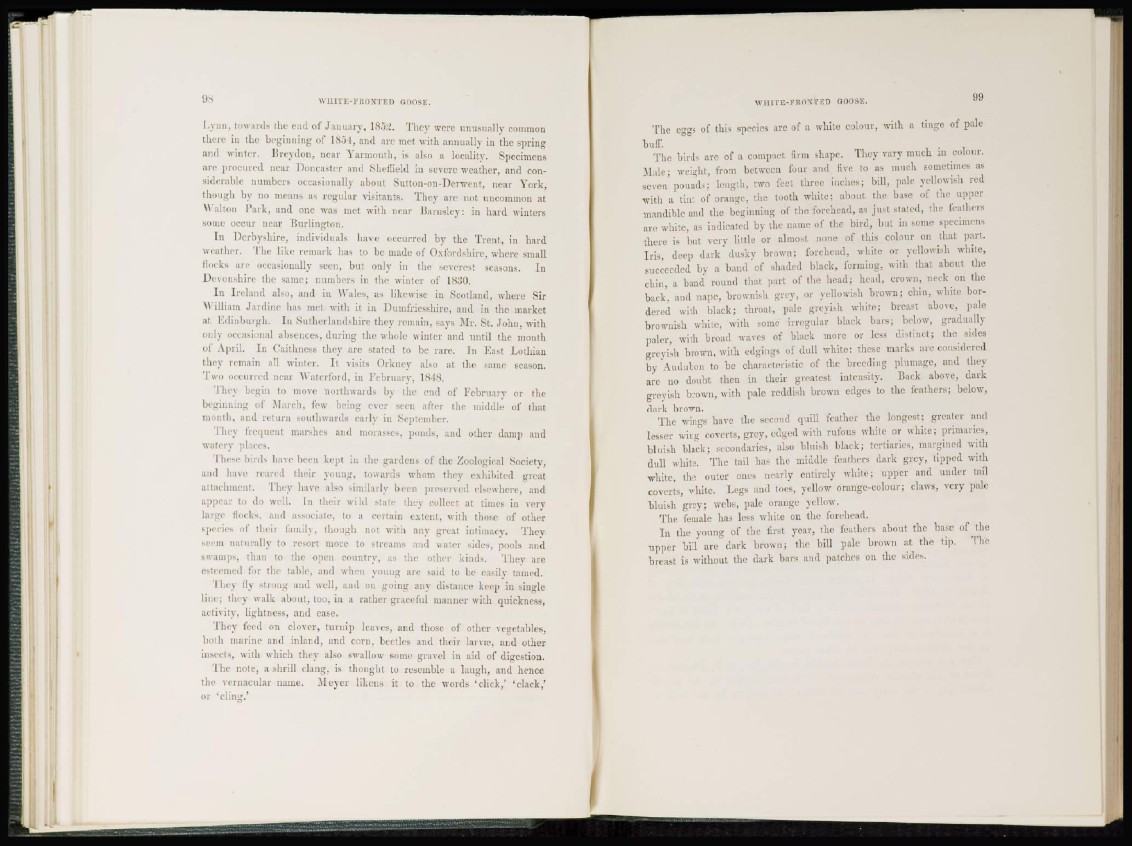
9s W H I T E - F R O N T E D GOOSE.
Lynn, towards the end of J a n u a r y , 185$. They were unusually common
there in the beginning of 1854, and are met with annually in the spring
and winter. Breydon, near Yarmouth, is also a locality. Specimens
are procured near Doncaster and Sheffield in severe weather, and considerable
numbers occasionally about Sutton-on-I)erwent, near York,
though by no means as regular visitants. They are not uncommon at
Walton Park, and one was met with near Barnaley: in hard winters
some occur near Burlington.
In Derby shire, individuals have occurred by the Trent, in hard
weather. The like remark has to be made of Oxfordshire, where small
flocks are occasionally seen, but only in the severest seasons. In
Devonshire the same; numbers in the winter of LSoO.
I n Ireland also, and in Wales, as likewise in Scotland, where Sir
William Jar d i n e has met witli it in Dumfriesshire, and in the market
at Edinburgh. In Sutherlandshire they remain, says Mr. St. John, with
md\ occasional absences, during the whole winter and until the month
of April. In Caithness they are stated to be rare. In East Lothian
they remain all winter. It visits Orkney also at the same season.
Two occurred near W aterford, in l'i bruary, 1848.
They begin to move northwards by the end of Fcbruarv or the
beginning of March, few being ever seen after the middle of that
month, and return southwards early in September.
They frequent marshes and morasses, ponds, and other damp and
watery places.
These birds have been kept in the gardens of the Zoological Society,
and have reared their young, towards whom they exhibited great
attachment. They have also similarly been preserved elsewhere, and
appear to do well. In their wild state they collect at times in very
large Hocks, and associate, to a certain extent, with those of other
species of their family, though not with any great intiuiacv. Tliev
seem naturally to resort more to streams and water sides, pools and
swamps, than to the open country, as the other kinds. They are
esteemed for the table, and when young arc said to be easily tamed.
They tlv strong and well, and on going any distance keep in single
line; they walk about, too, in a rather graceful manner with quickness,
activity, lightness, and ease.
They feed on clover, turnip leaves, and those of other vegetables,
both marine and inland, and corn, beetles and their larva1 , and other
insects, with which they also swallow some gravel in aid of digestion.
The note, a shrill clang, is thought to resemble a laugh, and hence
the vernacular name. Meyer likens it to the words 'click,' 'clack,'
or 'cling.'
W H I T E - F R O X T F . D GOOSE. 99
The eggs of this species are of a white colour, with a tinge of pale
buff.
The birds are of a compact firm shape. They vary much in colour.
Male; weight, from between four and five to as much sometimes as
seven pounds; length, two feet three inches; bill, pale yellowish red
with a tint of orange, the tooth white; about the base of the upper
mandible and the beginning of the forehead, as just stated, the feathers
are white, as indicated by the name of the bird, but in some specimens
there is but very little or almost none of this colour on that part.
I r i s , deep dark dusky brown; forehead, white or yellowish white,
succeeded by a band of shaded black, forming, with that about the
chin, a band round that part of the head; head, crown, neck on the
back, and nape, brownish grey, or yellowish brown; chin, white bordered
with black; throat, pale greyish white; breast above, pale
brownish white, with some irregular black bars; below, gradually
paler, with broad waves of black more or less distinct; the sides
greyish brown, with edgings of dull white: these marks arc considered
by Audubon to be characteristic of the breeding plumage, and they
are no doubt then in their greatest intensity. Back above, dark
greyish brown, with pale reddish brown edges to the feathers; below,
dark brown.
The wings have the second quill feather the longest; greater and
lesser wing coverts, grey, edged with rufous white or white; primaries,
bluish black; secondaries, also bluish black; tcrtiaries, margined with
dull white. The tail lias the middle feathers dark grey, tipped with
white, the outer ones nearly entirely white; upper and under tail
coverts, white. Legs and toes, yellow orange-colour; claws, very pale
bluish grey; webs, pale orange yellow.
The female has less white on the forehead.
I n the young of the first year, the feathers about the base of the
upper bill are dark brown; the bill pale brown at the tip. The
breast is without the dark bars and patches on the sides.